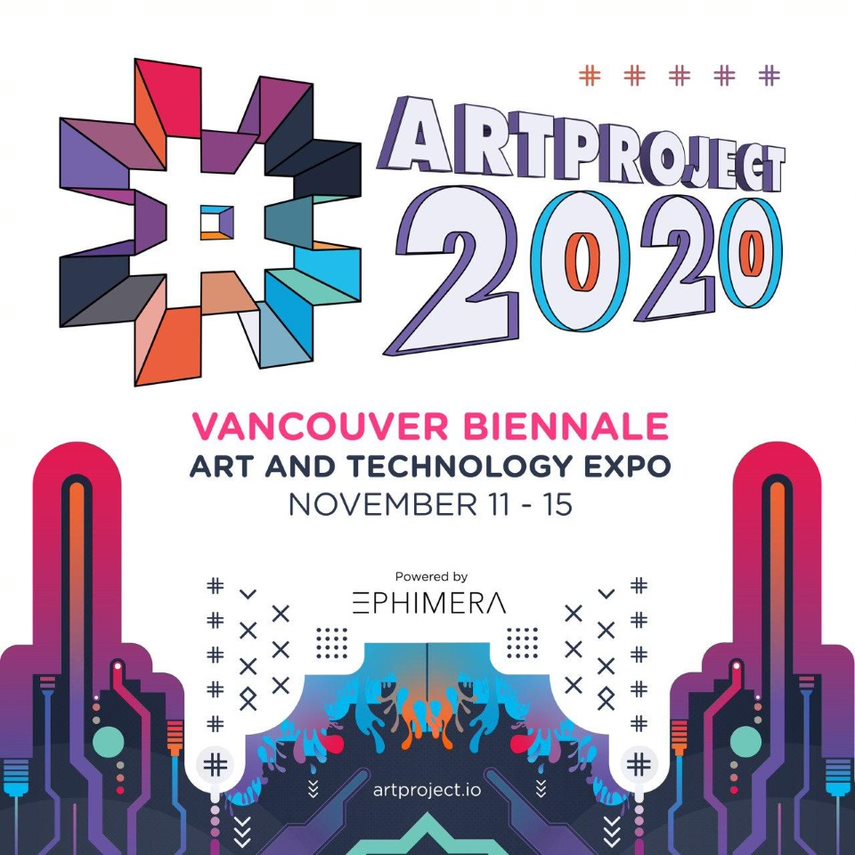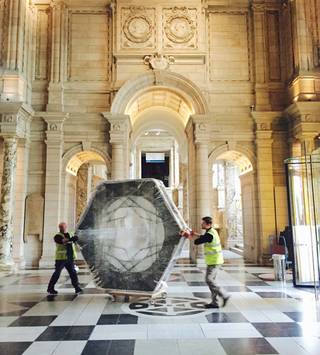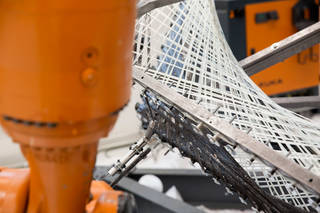It’s a bit odd that the organizers for an event held in Canada would arrange to have Remembrance Day for the opening day and not make any acknowledgements. (For those not familiar with it, here’s more about Remembrance Day (Wikipedia entry) and there’s more here on the Canadian Broadcasting Corporation’s [CBC] Remembrance Day 2020 webpage and on this Nov. 10, 2020 ‘Here’s everything you need to know about the poppy’ article for the Daily Hive.)
The event description is quite exciting and the poster image is engaging, although ….

Did they intend for the blocks to the left and right (gateway to the bridge?) to look like someone holding both hands giving you the finger on each side? Now that I’ve seen it, I can’t ‘unsee’ it.
Moving on, there’s more information about the expo from a Nov. 9, 2020 Vancouver Biennale announcement (received via email),
The Vancouver Biennale announces a global invitation to #ArtProject2020, a free virtual art and technology expo about how the latest technologies are influencing the art world. The expo will run from November 11th to 15th and feature over 80 international speakers and 40 events offering accessible information and educational resources for digital art. Everyone with a personal or professional interest in art and technology, including curators, galleries, museums, artists, collectors, innovators, experience designers, and futurists will find the expo fascinating and is invited to register. Trilingual programming in English, Spanish, and Chinese will be available.
To reserve a free ticket and see the complete speaker list and schedule, visit www.artproject.io.
Curated by New York-based Colombian artist Jessica Angel, the expo will accompany the Vancouver Biennale’s first exhibition of tokenized art with new works by Jessica Angel, Dina Goldstein, Diana Thorneycroft, and Kristin McIver. Tokenized art is powered by blockchain technology and has redefined digital artwork ownership, allowing artists and collectors the benefit of true digital scarcity. The exhibition will be launched via the blockchain marketplace, Ephimera.
About the Expo
Panel Discussions, Artist Talks, Keynote Speakers: Innovators, curators, legal experts, and artists working at the leading edge of digital art will cover topics including What Is Cryptoart?, Finding Opportunity in the Digital, Women Leading the Art and Tech Movement, The Art of Immersion, Decentralising Power and Resources in the Art World, and Tools for Artists and Collectors. Speakers include The Whitney Museum, Victoria & Albert Museum, Christie’s, Foundation for Art and Blockchain, SuperRare, and Art in America.
Learning: Barrier-free educational workshops will teach participants about using open-source and accessible innovative tools to create, monetize, and collect digital art. Workshops are integrated with various blockchain projects to drive adoption through experience. Featured presenters include Ephimera, Status, and MakerDAO. Indigenous Matriachs 4 will present from the Immersive Knowledge Transfer series for XR media creators, artists, and storytellers from diverse cultural communities.
Activities: A Crypto-Art Puzzle will drop clues every day of the event, and the Digital Art Battle will challenge artists to draw live. This gamified experience will offer winners rewards in different tokens. Participates can also join the Rare AF team on a Virtual Gallery Tour through the Metaverse, where gallery owners will share the inspirations behind their virtual spaces.
Anchoring the virtual expo is a future physical installation by Jessica Angel. Cleverly titled Voxel Bridge, this public artwork will transform the area underneath Vancouver’s Cambie Street Bridge into a three-layered immersive experience to transport visitors between physical and digital worlds. Working with the vastness of the concrete bridge as first layer, Angel adds her site-specific installation as a second layer, and completes the experience with augmented reality enhancements over the real world as the third and final layer. The installation is slated for completion in Spring 2021 as part of the Vancouver Biennale Exhibition.
“I never want to see the Biennale stuck in the past, presenting only static sculpture in an ever-changing world. We work with what comes next, the yet unknown, and we want to go where the future is heading and where public art has, perhaps, always been going. I am excited for this expo and the next chapter of the Biennale.” – Barrie Mowatt, Founder & Artistic Director of Vancouver Biennale
“Art is a mobilizing force with the power to bridge seemingly dissimilar worlds, and Voxel Bridge exhibits this capacity. This expo transcends the enjoyment of art into a unifying and experimenting effort, that enables blockchain technology and established art institutions to examine ways of interaction. Join us in the virtual public space, to learn, and to cultivate new forms of participation.” – Jessica Angel, Artist
Do check the schedule: http://www.artproject.io/ (keep scrolling) and don’t forget it’s free in exchange for your registration information. Enjoy!


![[downloaded from http://www.bbc.com/news/entertainment-arts-36322731]](http://www.frogheart.ca/wp-content/uploads/2016/05/VA_KukaEvent.jpg)
